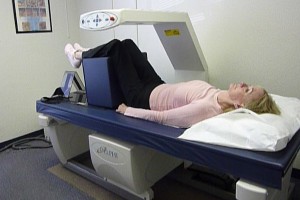
The most common bone density scan is often referred to by its abbreviation DXA or DEXA. The latter is the preferred term. Dual Energy X-ray Absorptiometry is the full name. The name is descriptive of the technique used to measure the amount of bone mineral density. Two different energy levels of x-ray beams pass through a portion of the body scanned. The difference in the x-ray absorptions allows the bone to be subtracted from the surrounding tissues. Bone mineral density is calculated measurement: bone mineral content (BMC) divided by the bone area.
DXA scanners can be in tabletop versions that measure the spine, hip, forearm, and whole body or portable units that measure forearm, heel, or finger. Diagnosis according to the World Health Organization criteria is based on the results of the lumbar spine, total hip, neck region of the hip (femoral neck), or forearm. The entire spine may be scanned on most tabletop DXA machines to assess for fractures referred to as Vertebral Fracture Assessment (VFA). This test may be included as part of your bone density scan of your hip and spine.
